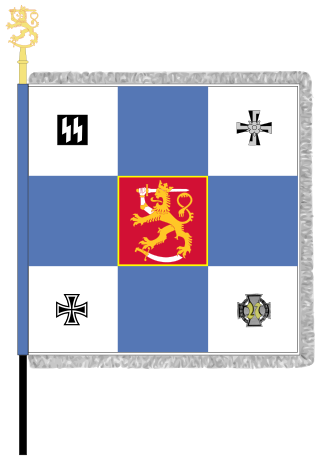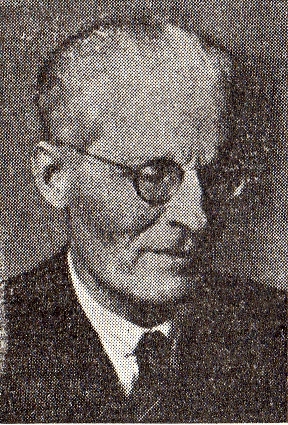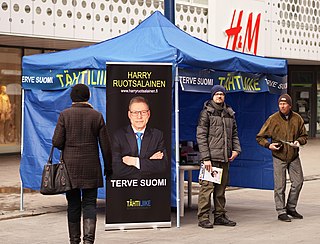
Patriotic People's Movement was a Finnish nationalist and anti-communist political party. IKL was the successor of the previously banned Lapua Movement. It existed from 1932 to 1944 and had an ideology similar to its predecessor, except that IKL participated in elections with limited success.

Iisakki Vihtori Kosola was a Finnish politician, activist and a farmer who served as the leader of the far-right and anti-communist Lapua Movement political party, and later as the leader of the Patriotic People's Movement political party in Finland.

From 1941 to 1943, 1,408 Finns volunteered for service on the Eastern Front of World War II in the Waffen-SS, in units of the SS Division Wiking. Most of these volunteers served as motorized infantry in the Finnish Volunteer Battalion of the Waffen-SS. The unit was disbanded in mid-1943 as the volunteers' two-year commitment had expired and the Finnish government was unwilling to allow more men to volunteer. In 1944-1945 a company sized unit of Finnish defectors recruited to the SS continued fighting alongside Germany.

Jooseppi Julius Mikkola, was Finnish linguist and professor. Mikkola is regarded as one of the most important Finnish linguists of Slavic languages of his era.

Movement Now is an economically liberal political party in Finland.

Seven Star Movement was a Finnish political party founded in 2018. The party was founded by Paavo Väyrynen, its president and only MP, after he was ousted from his previous party, Citizens' Party. The Seven Star Movement shut down its activities after the 2019 European Parliament election and was de-registered in 2023 after failing to win seats in two consecutive parliamentary elections.

Finnish People First was a nationalist political party in Finland. It was founded in 2018 and de-registered in 2023 after failing to win seats in two consecutive parliamentary elections. In July 2023, the party filed for bankruptcy and announced its dissolution.

The Patriotic People's Movement was a political organization in Finland. It regarded itself as the successor of the original Patriotic People's Movement that had operated in the interwar years until the end of the Continuation War. After a few active years and moderate success fighting for the legacy of the bankrupt populist Finnish Rural Party, IKL failed to be admitted to the party register and its activities died out after 1998.

In Finland, the far right was strongest in 1920–1940 when the Academic Karelia Society, Lapua Movement, Patriotic People's Movement (IKL) and Vientirauha operated in the country and had hundreds of thousands of members. In addition to these dominant far-right and fascist organizations, smaller Nazi parties operated as well.
The Blue Cross was a Finnish Nazi organization active from 1942 to 1944.

The Peasant March was a demonstration in Helsinki on 7 July 1930 by the far-right Lapua movement, attended by more than 12,000 supporters from all over the country. It was the most significant show of strength in the short history of the Lapua movement, aimed primarily at the Communists, but it was also intended to put pressure on the Finnish government. President Lauri Relander, Prime Minister Pehr Evind Svinhufvud, among others, were invited guests at the main event held at the Senate Square. In addition present were right-wing MPs, the country's military leadership, and General Mannerheim, commander-in-chief of the Civil War White Army. The peasant march was intentionally reminiscent of the White Victory Parade of 16 May 1918, and also followed its route.
Rising Finland was a Finnish political association founded on October 5, 1940. It aimed to "nurture the Spirit of the Winter War", promote the idea of a united people, to reorganize the bourgeois party field and to create a stronger leadership and increasing personal responsibility. According to the organization, its goal was to bring together citizens around national symbols whose value was "perceived by all our people in the great trials of the 1939-1940 War of Independence".

Martti Aleksander Pihkala was a National Coalition Party MP who became known as a Jäger activist, Ostrobothnia White Guard founder, in the 1920s and 1930s, leader of the strikebreaking organisation Vientirauha, also known as "Pihkala's Guard" and an influencer of the Lapua movement and the Patriotic People's Movement.

The Vaasa riot took place on 4 June 1930 in Vaasa, Finland. The riot unfolded with a violent attack by radical members of the right wing Lapua Movement on Communist supporters and bystanders at a court house in Vaasa. No intervention was witnessed of the police, as the police stood watching the attack.
Niilo Vilho Rauvala was a Finnish engineer and the chairman of the far-right Lalli Alliance of Finland and the Nazi Party of Finnish Labor in the 1930s and 1940s.
The Lalli Alliance of Finland was a Finnish far-right organization founded in 1929. The main themes of the Lalli Alliance were Finnish language nationalism and opposition to communism, parliamentarism and democracy. The aim of the organization was a coup and the appointment of a dictator to lead Finland. The most significant achievement of the organization is considered to be that the Lalli Alliance has been considered to have acted as a precursor to the Lapua movement.

The Blue-and-Blacks (Sinimustat) was a fascist youth organization that operated in Finland from 1930 to 1936, initially affiliated with the Lapua movement and then the Patriotic People's Movement (IKL).
Front Soldier League was a Finnish civil war White Guard veteran organization between the years 1929 and 1944, which also had extreme right-wing political objectives. In the early 1930s, it had close links with the Lapua movement, in which the leaders of the League played an important role. The Front Soldier League was abolished in 1944 on the basis of the Moscow peace treaty, which forbade fascist organizations. It had a sister organization for women, the Front Soldier Women's League, which was also disbanded.

Pan-Finnicism, also known as Pan-Fennicism or sometimes even referred to as Finno-Ugrism or even Heimoaate is a pan-nationalist idea which advocates for the political or economic unification of the Finno-Ugric peoples. The idea is broad in its meaning and oftentimes it simply refers to the Finno-Ugric peoples, however on rare occasion it can be limited to only the Baltic Finnic peoples or even the wider scale Finnic peoples.













